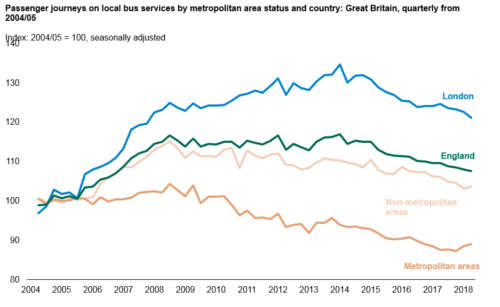A continued fall in bus use over the last four years has prompted calls for a national bus strategy from a leading operator to stem the tide of local cuts.
The latest government statistics show the trend of falling bus use has continued in London and across England in the last quarter, while at the same time fares have gone up.

DfT is considering expanding £20m new station fund
The Go-Ahead Group - London’s largest bus operator - has highlighted that while the Department for Transport has clear strategies for rail, roads, aviation, cycling and walking, it does not have one for bus services.
The company said a strategy was 'urgently required to boost patronage, tackle congestion, improve air quality and address social exclusion'.
Such a strategy should incentivise bus prioritisation measures to reduce congestion and deliver smart solutions – such as demand-responsive transport – to meet changing consumer demand, Go-Ahead Group argued.
It stated that buses play a 'critical role in helping to boost economic growth – providing greater access to jobs and education, tackling air pollution and congestion, as well as addressing rising rates of loneliness and social exclusion' in a submission to the Transport Select Committee.
According to figures from the Campaign for Better Transport, 3,347 bus services have been reduced or withdrawn across England and Wales since 2010, driven by a 45% reduction in funding for bus services.
In 2017-18 alone there was a £20.2m cut to services a 9% reduction since 2016-17.
'It’s a worrying sign that the English bus network has shrunk to its smallest size in more than 20 years. Passenger numbers have dropped by 9% since 2008 – we have to take action,' said David Brown, Go-Ahead Group’s Chief Executive Officer.
'Rail, cycling and walking all have national strategies to secure the future of these sustainable modes of transport – so why not bus, a service which delivers more than 2.2bn journeys outside of London every year.'
Martin Dean, managing director of bus development at Go-Ahead, added buses were 'vulnerable to local authority spending cuts because there is not a statutory requirement for councils to provide these services'.
'At the moment what we’re doing in urban areas is adding to our costs just to maintain the existing times and existing frequencies because traffic congestion is so bad. When traffic speeds are reduced by around 50%, then air quality tends to deteriorate by about 50%,' Mr Dean said.
'Everyone is stuck in traffic, engines are not working efficiently and exhausts are churning out dirty diesel and petrol.'
The latest DfT bus stats at a glance:
For the year ending June 2018, the number of local bus passenger journeys in:
- England was 4.36 billion, a 1.5% decrease
- London decreased by 1.2%
- England outside London, decreased by 1.7%
Comparing local bus passenger journeys for April to June 2018 with April to June 2017:
- a 1.7% decrease in England
- bus use in London decreased by 2.8%
- England outside London decreased by 0.6%.
- Scotland decreased by 6.0%
- Wales increased by 1.0%
The local bus fares index increased by 3.2% in England between June 2017 and June 2018:
- 0.4% increase in London
- 2.2% increase in metropolitan areas
- 6.6% increase in non-metropolitan areas
The consumer prices index (CPI) increased by 2.4% over the same 12-month period.
Local bus fares increased by 4.5% in Scotland and 3.5% in Wales.
Register now for full access
Register just once to get unrestricted, real-time coverage of the issues and challenges facing UK transport and highways engineers.
Full website content includes the latest news, exclusive commentary from leading industry figures and detailed topical analysis of the highways, transportation, environment and place-shaping sectors.
Use the link below to register your details for full, free access.
Already a registered? Login